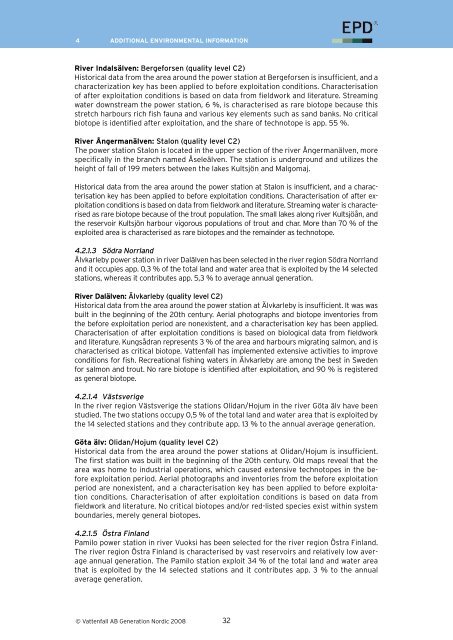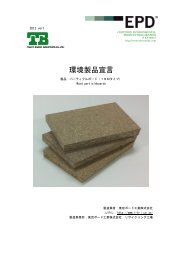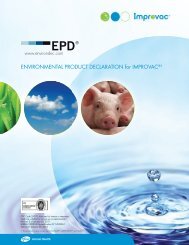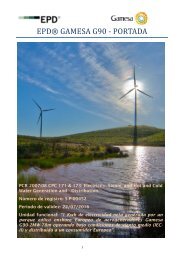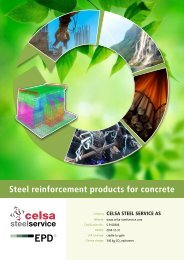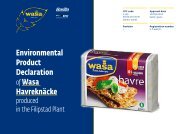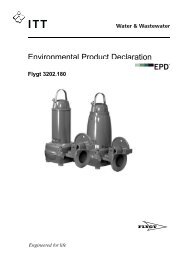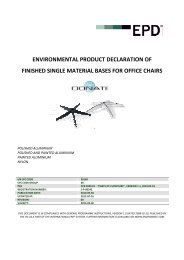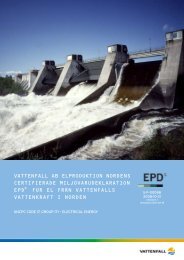Vattenfall aB GeneRatIOn nORDIC CeRtIfIeD enVIROnmental ...
Vattenfall aB GeneRatIOn nORDIC CeRtIfIeD enVIROnmental ...
Vattenfall aB GeneRatIOn nORDIC CeRtIfIeD enVIROnmental ...
You also want an ePaper? Increase the reach of your titles
YUMPU automatically turns print PDFs into web optimized ePapers that Google loves.
4 Additional environmental information<br />
River Indalsälven: Bergeforsen (quality level C2)<br />
Historical data from the area around the power station at Bergeforsen is insufficient, and a<br />
characterization key has been applied to before exploitation conditions. Characterisation<br />
of after exploitation conditions is based on data from fieldwork and literature. Streaming<br />
water downstream the power station, 6 %, is characterised as rare biotope because this<br />
stretch harbours rich fish fauna and various key elements such as sand banks. No critical<br />
biotope is identified after exploitation, and the share of technotope is app. 55 %.<br />
River Ångermanälven: Stalon (quality level C2)<br />
The power station Stalon is located in the upper section of the river Ångermanälven, more<br />
specifically in the branch named Åseleälven. The station is underground and utilizes the<br />
height of fall of 199 meters between the lakes Kultsjön and Malgomaj.<br />
Historical data from the area around the power station at Stalon is insufficient, and a characterisation<br />
key has been applied to before exploitation conditions. Characterisation of after exploitation<br />
conditions is based on data from fieldwork and literature. Streaming water is characterised<br />
as rare biotope because of the trout population. The small lakes along river Kultsjöån, and<br />
the reservoir Kultsjön harbour vigorous populations of trout and char. More than 70 % of the<br />
exploited area is characterised as rare biotopes and the remainder as technotope.<br />
4.2.1.3 Södra Norrland<br />
Älvkarleby power station in river Dalälven has been selected in the river region Södra Norrland<br />
and it occupies app. 0,3 % of the total land and water area that is exploited by the 14 selected<br />
stations, whereas it contributes app. 5,3 % to average annual generation.<br />
River Dalälven: Älvkarleby (quality level C2)<br />
Historical data from the area around the power station at Älvkarleby is insufficient. It was was<br />
built in the beginning of the 20th century. Aerial photographs and biotope inventories from<br />
the before exploitation period are nonexistent, and a characterisation key has been applied.<br />
Characterisation of after exploitation conditions is based on biological data from fieldwork<br />
and literature. Kungsådran represents 3 % of the area and harbours migrating salmon, and is<br />
characterised as critical biotope. <strong>Vattenfall</strong> has implemented extensive activities to improve<br />
conditions for fish. Recreational fishing waters in Älvkarleby are among the best in Sweden<br />
for salmon and trout. No rare biotope is identified after exploitation, and 90 % is registered<br />
as general biotope.<br />
4.2.1.4 Västsverige<br />
In the river region Västsverige the stations Olidan/Hojum in the river Göta älv have been<br />
studied. The two stations occupy 0,5 % of the total land and water area that is exploited by<br />
the 14 selected stations and they contribute app. 13 % to the annual average generation.<br />
Göta älv: Olidan/Hojum (quality level C2)<br />
Historical data from the area around the power stations at Olidan/Hojum is insufficient.<br />
The first station was built in the beginning of the 20th century. Old maps reveal that the<br />
area was home to industrial operations, which caused extensive technotopes in the before<br />
exploitation period. Aerial photographs and inventories from the before exploitation<br />
period are nonexistent, and a characterisation key has been applied to before exploitation<br />
conditions. Characterisation of after exploitation conditions is based on data from<br />
fieldwork and literature. No critical biotopes and/or red-listed species exist within system<br />
boundaries, merely general biotopes.<br />
4.2.1.5 Östra Finland<br />
Pamilo power station in river Vuoksi has been selected for the river region Östra Finland.<br />
The river region Östra Finland is characterised by vast reservoirs and relatively low average<br />
annual generation. The Pamilo station exploit 34 % of the total land and water area<br />
that is exploited by the 14 selected stations and it contributes app. 3 % to the annual<br />
average generation.<br />
© <strong>Vattenfall</strong> AB Generation Nordic 2008<br />
32


